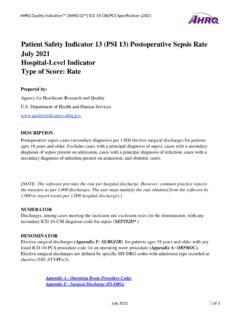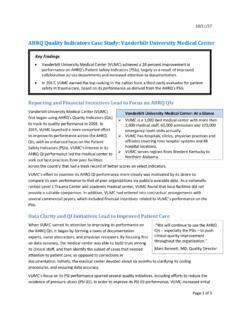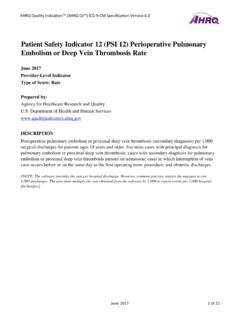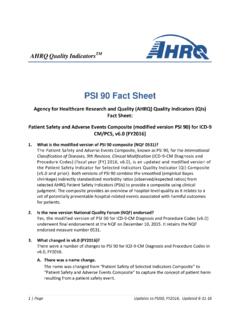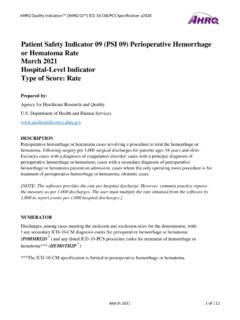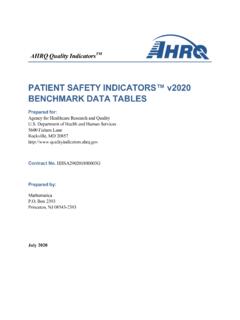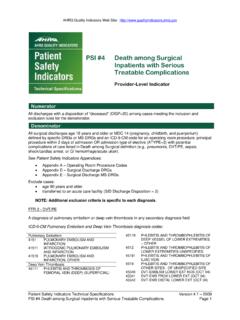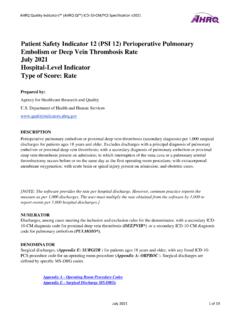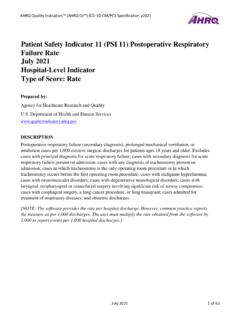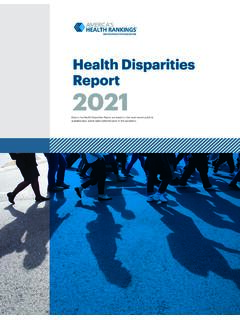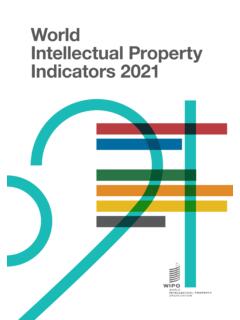Transcription of AHRQ Quality Indicators™ Patient Safety Indicators
1 AHRQ Quality Indicators Patient Safety Indicators Help assess Quality and Safety of care for adults in the hospital Patient Safety Indicators Can be used to help hospitals and healthcare organizations assess, monitor, track, andimprove the Safety of inpatient care. Can be used for comparative public reporting,trending, and pay-for-performance initiatives. Can identify potentially avoidable complicationsthat result from a Patient s exposure to the healthcare system. Include hospital-level Indicators to detectpotential Safety problems that occur during apatient s hospital stay.
2 Include area-level Indicators for potentiallypreventable adverse events that occur duringa hospital stay to help assess total incidencewithin a region. Are publicly available at no charge to the user. Include risk adjustment where appropriate. Can be downloaded at AHRQ Patient Safety Indicators were developed under a contract with the University of California, San Francisco, Stanford University Evidence-based Practice Center, and the University of California, Davis. Te Patient Safety Indicators were frst released in 2003 and have been updated as needed over time. Other AHRQ Quality Indicators AHRQ has other sets of QIs: Prevention Quality Indicators Indicatorsrepresenting hospital admission rates forcommon ambulatory care-sensitive for these types of conditions canoften be avoided with appropriate use of high- Quality , community -based primary care services.
3 Inpatient Quality Indicators Hospital- andarea-level Indicators relating to utilization,mortality, and volume. Hospital-levelindicators include in-hospital procedures forwhich outcomes can vary by hospital; area-level Indicators include procedures for whichinpatient utilization rates have been shown tovary by metropolitan statistical area. Pediatric Quality Indicators Hospital- andarea-level Indicators that focus on potentiallypreventable complications and errors inpediatric patients treated in hospitals. Includes asubset of Neonatal Quality for announcements of updates to AHRQ QI software.
4 Endorsement A number of measures have been endorsed by the National Quality Forum (NQF) through 2021. Beginning in fiscal year 2022, AHRQ will no longer seek NQF re-endorsement for its portfolio of measures in the AHRQ Quality Indicators (QIs) program. Find NQF-endorsed AHRQ measures at Mailing List Sign up for free notifications about new and updated AHRQ QIs and associated software tools by registering at Tools and Support Free software to compute AHRQ QI rates, available for SAS and Windows A detailed users guide and technical specifcations for the Patient Safety Indicators Parameter estimates, benchmark data tables.
5 And methodology to create composite measures Guidance for designing a report using the Patient Safety Indicators Answers to frequently asked questions Access to QI Technical Support by email at or by phone at 301-427-1949Pa tient Safety IndicatorsProvider-Level Indicators PSI 02 - Death rate in low-mortality diagnosis related groups (DRGs) PSI 03 - Pressure ulcer rate PSI 04 - Death rate among surgical inpatientswith serious treatable conditions PSI 05 - Retained surgical item or unretrieved device fragment count PSI 06 - Iatrogenic pneumothorax rate PSI 07 - Central venous catheter-related blood stream infection rate PSI 08 - Postoperative hip fracture rate PSI 09 - Perioperative hemorrhage or hematoma rate PSI 10 - Postoperative physiologic and metabolic derangement rate PSI 11 - Postoperative respiratory failure rate PSI 12 - Perioperative pulmonary embolism or deep vein thrombosis rate PSI 13.
6 Postoperative sepsis rate PSI 14 - Postoperative wound dehiscence rate PSI 15 - Accidental puncture or laceration rate PSI 17 - Birth trauma rate injury to neonate PSI 18 - Obstetric trauma rate vaginal delivery with instrument PSI 19 - Obstetric trauma rate-vaginal delivery without instrument PSI 90 - Patient Safety for Selected IndicatorsQI Web Site: AHRQ Pub. No. 15-M053-4-EF Replaces AHRQ Pub. No. 10-M043-4 Updated April 2022
